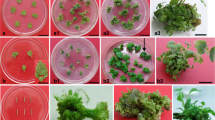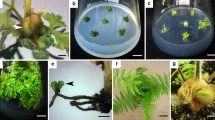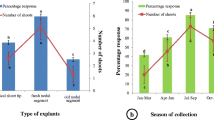Abstract
This article describes a fast, simple, and efficient plant regeneration protocol for Ocimum basilicum L. Two sets of experiments were performed. The first set was performed on Murashige and Skoog (MS) medium lacking zinc sulfate heptahydrate (ZnSO4·7H2O) and containing varying concentrations of indole-3-acetic acid (IAA). The second set used three different concentrations (8.6, 12.9, and 17.2 mg L−1) of ZnSO4·7H2O along with varying concentrations of IAA. In the first set, without zinc sulfate, an IAA concentration of 1.0 mg L−1 (MS4) was found to be most effective, producing a mean of 12.6 roots per hypocotyl explant, while shoots were not produced. In the second set, with zinc sulfate, a combination of 12.9 mg L−1 ZnSO4·7H2O + 1.0 mg L−1 IAA (MS11) produced significantly more shoots per explant (15 shoots) than a combination of 12.9 mg L−1 ZnSO4·7H2O + 0.5 mg L−1 IAA (MS10), which produced only six shoots. Later, the plantlets were successfully acclimatized (100%) and finally transferred to the greenhouse (ex vitro). In the O. basilicum plants grown using MS11 medium, total phenolic content and rosmarinic acid content were estimated from stem, shoot tip, and old leaf tissue of in vitro plantlets, ex vitro plantlets, and flowering plants. The highest amounts of total phenolic content (131.8 mg gallic acid equivalent g−1 DW) and rosmarinic acid (13.0 mg g−1 DW) were obtained in the old leaf tissue at flowering time. This rapid regeneration protocol for O. basilicum L. represents a major improvement over the conventional protocols for plant regeneration and propagation of this species.


Similar content being viewed by others
References
Archana R, Namasivayam A (2002) A comparative study of different crude extracts of Ocimum sanctum on noise stress. Phytother Res 16:579–580
Begum F, Amin M, Azad M (2002) In vitro rapid clonal propagation of Ocimum basilicum L. Plant Tissue Cult 12:27–35
Çirak C, Radušienė J, Ivanauskas L, Janulis V (2007) Variation of bioactive secondary metabolites in Hypericum origanifolium during its phenological cycle. Acta Physiol Plant 29:197–203
Dahleen LS, Bregitzer P (2002) An improved media system for high regeneration rates from barley immature embryo-derived callus cultures of commercial cultivars. Crop Sci 42:934–938
De-Eknamkul W, Ellis B (1985) Effects of auxins and cytokinins on growth and rosmarinic acid formation in cell suspension cultures of Anchusa officinalis. Plant Cell Rep 4:50–53
De-Eknamkul W, Ellis BE (1988) Rosmarinic acid: production in plant cell cultures. In: Bajaj YPS (ed) Medicinal and aromatic plants I. Biotechnology in agriculture and forestry, vol 4. Springer, Berlin, Heidelberg, pp 310–329
Dube S, Upadhyay P, Tripathi S (1989) Antifungal, physicochemical, and insect-repelling activity of the essential oil of Ocimum basilicum. Can J Bot 67:2085–2087
Duncan DB (1955) Multiple range and multiple F tests. Biometrics 11:1–42
Ekmekci H, Aasim M (2014) In vitro plant regeneration of Turkish sweet basil (Ocimum basilicum L.). J Anim Plant Sci 24:1758–1765
Gopi C, Ponmurugan P (2006) Somatic embryogenesis and plant regeneration from leaf callus of Ocimum basilicum L. J Biotechnol 126:260–264
Graham RD, Welch RM, Bouis HE (2001) Addressing micronutrient malnutrition through enhancing the nutritional quality of staple foods: principles, perspectives and knowledge gaps. Adv Agron 70:77–142
Hakkim FL, Shankar CG, Girija S (2007) Chemical composition and antioxidant property of holy basil (Ocimum sanctum L.) leaves, stems, and inflorescence and their in vitro callus cultures. J Agric Food Chem 55:9109–9117
Heywood VH (1993) Flowering plants of the world. BT Batsford Ltd, London, p 263
Hossain B, Hirata N, Nagatomo Y, Akashi R, Takaki H (1997) Internal zinc accumulation is correlated with increased growth in rice suspension culture. J Plant Growth Regul 16:239–243
Juliani HR, Koroch AR, Simon JE (2008) Basil: a new source of rosmarinic acid. In: Ho CT, Simon JE, Shahidi F, Shao Y (eds) Dietary supplements. American Chemical Society Symposium Series, vol 987. ACS, Washington, DC, pp 129–143
Kiferle C, Lucchesini M, Mensuali-Sodi A, Maggini R, Raffaelli A, Pardossi A (2011) Rosmarinic acid content in basil plants grown in vitro and in hydroponics. Cent Eur J Biol 6:946–957
Kintzios S, Makri O, Panagiotopoulos E, Scapeti M (2003) In vitro rosmarinic acid accumulation in sweet basil (Ocimum basilicum L.). Biotechnol Lett 25:405–408
Kirtikar KR, Basu BD (2003) Indian medicinal plants with illustrations, 2nd edn. Vol VIII. Oriental Enterprises, Uttaranchal, India, pp 2701–2705
Kobayashi A, Sakamoto A, Kubo K, Rybka Z, Kanno Y, Takatsuji H (1998) Seven zinc‐finger transcription factors are expressed sequentially during the development of anthers in petunia. Plant J 13:571–576
Lepp NW (1981) Effect of heavy metal pollution on plants. Vol. 1. Effects of trace metals on plant function. Applied Science, London and New Jersey
Marigo G, Boudet AM (1979) Effects of an increase in levels of phenolic compounds on the auxin content and growth of Lycopersicum esculentum. Z Pflanzenphysiol 92:33–38
Maxwell SE, Delaney HD (2004) Designing experiments and analyzing data: a model comparison perspective (2nd ed.). Erlbaum, Mahwah, NJ
Murashige T, Skoog F (1962) A revised medium for rapid growth and bioassays with tobacco tissue cultures. Plant Physiol 15:473–497
Oguchi K, Tanaka N, Komatsu S, Akao S (2004a) Characterization of NADPH‐dependent oxidoreductase induced by auxin in rice. Physiol Plant 121:124–131
Oguchi K, Tanaka N, Komatsu S, Akao S (2004b) Methylmalonate-semialdehyde dehydrogenase is induced in auxin-stimulated and zinc-stimulated root formation in rice. Plant Cell Rep 22:848–858
Pande D, Iqbal M, Srivastava P (2000) Effect of ZnSO4 and CuSO4 on regeneration and lepidine content in Lepidium sativum L. Biol Plant 43:253–256
Phippen WB, Simon JE (2000) Shoot regeneration of young leaf explants from basil (Ocimum basilicum L.). In Vitro Cell Dev Biol Plant 36:250–254
Rady MR, Nazif NM (2005) Rosmarinic acid content and RAPD analysis of in vitro regenerated basil (Ocimum americanum) plants. Fitoterapia 76:525–533
Ramesh SA, Choimes S, Schachtman DP (2004) Over-expression of an Arabidopsis zinc transporter in Hordeum vulgare increases short-term zinc uptake after zinc deprivation and seed zinc content. Plant J Mol Biol 54:373–385
Saeki Y, Yasukouchi A, Nagatomo Y, Takaki H (2000) Distinctive expression of a zinc-binding protein in rice callus grown in medium with high zinc concentration. Soil Sci Plant Nutr 46:209–216
Sahoo Y, Pattnaik S, Chand P (1997) In vitro clonal propagation of an aromatic medicinal herb Ocimum basilicum L. (sweet basil) by axillary shoot proliferation. In Vitro Cell Dev Biol Plant 33:293–296
Sahu R, Dewanjee S, Gangopadhyay M (2013) Bioproduction and optimization of rosmarinic acid production in Solenostemon scutellarioides through media manipulation and conservation of high yielding clone via encapsulation. Nat Prod Commun 8:1275–1278
Shier WT (1994) Metals as toxins in plants. Toxin Rev 13:205–216
Siddique I, Anis M (2007) Rapid micropropagation of Ocimum basilicum using shoot tip explants pre-cultured in thidiazuron supplemented liquid medium. Biol Plant 51:787–790
Sytar O, Borankulova A, Hemmerich I, Rauh C, Smetanska I (2014) Effect of chlorocholine chlorid on phenolic acids accumulation and polyphenols formation of buckwheat plants. Biol Res 47:19
Welch RM, Shuman L (1995) Micronutrient nutrition of plants. Crit Rev Plant Sci 14:49–82
Yanagisawa S (2004) Dof domain proteins: plant-specific transcription factors associated with diverse phenomena unique to plants. Plant Cell Physiol 45:386–391
Zhao Y (2010) Auxin biosynthesis and its role in plant development. Annu Rev Plant Biol 61:49–64
Acknowledgments
The authors thank TUBITAK for partial financial support. We are grateful to the Department of Biology, Abant Izzet Baysal University, for providing lab facilities. We also thank N. Sahbaz for providing the O. basilicum seeds.
Author information
Authors and Affiliations
Corresponding author
Additional information
Editor: Neftali Ochoa-Alejo
Rights and permissions
About this article
Cite this article
Verma, S.K., Sahin, G., Das, A.K. et al. In vitro plant regeneration of Ocimum basilicum L. is accelerated by zinc sulfate. In Vitro Cell.Dev.Biol.-Plant 52, 20–27 (2016). https://doi.org/10.1007/s11627-015-9739-0
Received:
Accepted:
Published:
Issue Date:
DOI: https://doi.org/10.1007/s11627-015-9739-0




